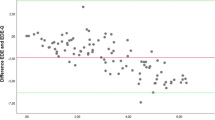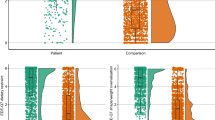Abstract
OBJECTIVES: The aim of the present study was to evaluate the concurrent validity, specificity and sensitivity of the Disordered Eating Questionnaire (DEQ). The DEQ is a brief questionnaire (24 items), that can be used for epidemiological screenings. It addresses face valid questions to evaluate frequency and intensity of disordered eating attitudes and behaviors over a time frame of three months. DESIGN: The study was conducted using a cross-sectional design. METHODS: The DEQ was completed by 190 eating disordered patients (73 patients with Anorexia, 48 with Bulimia, 11 with Binge Eating Disorder, 48 with Eating Disorders Not Otherwise Specified, 10 recovered patients) and 88 healthy controls. RESULTS: In the whole group, DEQ scores were highly correlated with the scores of the Eating Disorder Examination (EDE 12.0D). Sensitivity and specificity were evaluated. In the female subsample, the ROC curves indicate that a cut-off score of 30 allows to obtain a sensitivity of 82% and a specificity of 68%. A formative approach of Structural Equationing Model confirm the construct validity of the instrument. CONCLUSIONS: The DEQ confirm to be a valid and reliable instrument, whose sensitivity and specificity is comparable to that of the EAT-40 even though it has fewer items.
Similar content being viewed by others
References
Fairburn CG, Cooper Z. The Eating Disorder Examination. In: Fairburn CG, Wilson GT, (Eds) Binge eating: Nature, Assessment and treatment (12th ed.). New York, Guilford Press, 1993.
Cooper Z, Fairburn CG. The Eating Disorder Examination: a semi-structured interview for the assessment of the specific psychopatology of eating disorders. Int J Eat Disord 1987; 6: 1–8.
Fairburn CG, Beglin SJ. The assessment of eating disorders: interview or self-report questionnaire. Int J Eat Disord 1994; 16: 363–70.
Whitehouse AM, Cooper PJ, Vize CV, et al. Prevalence of eating disorders in three Cambridge general practices: hidden and conspicuous morbidity. Br J Gen Pract 1992; 42: 57–60.
Guarda AS. Treatment of anorexia nervosa: insights and obstacles. Physiol Behav 2008; 94: 113–20.
Garner DM, Garfinkel PE. The Eating Attitudes Test: an index of the symptoms of anorexia nervosa. Psychol Med 1979; 9: 273–9.
Garner DM, Olmstead MP, Bohr Y, et al. The Eating Attitude Test: psychometric features and clinical correlates. Psychol Med 1982; 12: 871–8.
Garner DM, Olmsted MP. Scoring the Eating Disorder Inventory. Am J Psychiatry 1986; 143: 680–1.
Garner DM. Eating Disorder Inventory-2: Professional Manual. Odessa, FL, Psychological Assessment Resources, 1991.
Garner DM, Lutz, FL. Eating Disorder Inventory-3: Professional Manual. Psychol Assess Res, 2004.
Nasser M. The EAT speaks many languages: review of the use of the EAT in eating disorders research. Eat Weight Disord 1997; 2: 174–81.
Garfinkel PE, Newman A. The Eating Attitudes Test: twenty-five years later. EatWeight Disord 2001; 6: 1–24.
Morgan JF, Reid F, Lacey JH. The SCOFF questionnaire: assessment of a new screening tool for eating disorders. BMJ 1999; 319: 1467–8.
Perry L, Morgan JF, Reid F, et al. Screening for symptoms of eating disorders: reliability of the SCOFF Screening tool with written compared to oral delivery. Int J Eat Disord 2002; 32: 466–72.
Rueda GE, Díaz LA, Campo A, et al. Validación de la encuesta SCOFF para tamizaje de trastornos de la conducta alimentaria en mujeres universitarias. Biomedica: revista del Instituto Nacional de Salud 2005; 25: 196–202.
Parker SC, Lyons J, Bonner J. Eating disorders in graduate students: Exploring the SCOFF questionnaire as a simple screening tool. J Am Coll Health 2005; 54: 103–7.
Favaro A, Santonastaso P. Costruzione e validazione di un nuovo strumento di screening per i disturbi dell’alimentazione: The Inventory for the Screening of Eating Disorders (ISED). Epidemiol Psichiatr Soc 2000; 9: 26–35.
Santonastaso P, Scicluna D, Colombo G, et al. Eating Disorders and Attitudes in Maltese and Italian Female Students. Psychopath 2006; 39: 153–7.
Katiala-Heino R, Rissanen A, Rimpela M, et al. Bulimia and bulimic behavior in middle adolescence: more common than thought? Acta Psychiatr Scand 1999; 100: 33–9.
Ghaderi A, Scott B. Prevalence and psychological correlates of eating disorders among female aged 18–30 years in the general population. Acta Psychiatr Scand 1999; 99: 261–6.
Wilson GT. Assessment of binge eating. In: Fairburn CG, Wilson GT (Eds) Binge eating: nature, assessment and treatment. New York, Guilford Press, 1993.
Carter JC, Stewart DA, Fairburn CG. Eating Disorder Examination Questionnaire: norms for young adolescent girls. Behav Res Ther 2001; 39: 625–32.
Lombardo C, Russo PM, Lucidi F, et al. Internal consistency, convergent validity and reliability of a brief Questionnaire on Disordered Eating (DEQ). Eat Weight Disord 2004; 9: 91–8.
Carter JC, Aime A, Mills JS. Assessment of bulimia nervosa: a comparison of interview and self-report questionnaire methods. Int J Eat Disord 2001; 30: 187–92.
Fairburn CG, Beglin SJ. Eating Disorder Examination Questionnaire (EDE-Q 6.0). In: Fairburn CG (Ed) Cognitive behavior therapy and eating disorders. New York, Guilford Press, 2008.
Peterson CB, Crosby RD, Wonderlich SA, et al. Psychometric properties of the Eating Disorder Examination Questionnaire: Factor structure and internal consistency. Int J Eat Disord 2007; 40: 386–9.
Wilfley DE, Schwartz MB, Spurrell EB, et al. Assessing the specific psychopathology of binge eating disorder patients: interview or self-report? Behav Res Ther 1997; 35: 1151–9.
Luce KH, Crowther JH. The reliability of the Eating Disorder Examination — Self-Report Questionnaire (EDE-Q). Int J Eat Disord 1999; 25: 349–51.
Becker AE, Thomas JJ, Bainivualiku A, et al. Validity and reliability of a Fijian translation and adaptation of the Eating Disorder Examination Questionnaire. Int J Eat Disord 2010; 43: 171–8.
Lavender JM, De Young KP, Anderson DA. Eating Disorder Examination questionnaire (EDE-Q): Norms for undergraduate men. Eat Behav 2010; 11: 119–21.
Mond JM, Hay PJ, Rodgers B, et al. Eating Disorder Examination Questionnaire (EDE-Q): norms for young adult women. Behav Res Ther 2006; 44: 53–62.
Binford RB, Le Grange D, Jellar CC. Eating Disorders Examination versus Eating Disorders Examination-Questionnaire in adolescents with full and partial syndromes bulimia nervosa and anorexia nervosa. Int J Eat Disord 2005; 37: 44–9.
Iani L, Lombardo C, Violani C. Effetti di un intervento per la promozione di comportamenti alimentari sani negli adolescenti. Ricerche di Psicologia 2005; 28 (Special issue — Equality and diversity): 141–59.
Thompson MA, Gray JJ. Development and validation of a new Body-Image Assessment Scale. J Pers Assess 1995; 64: 258–69.
Dotti A, Lazzari R. Validation and reliability of the Italian EAT-26. EatWeight Disord 1998; 3: 188–94.
Mannucci E, Ricca V, Di Bernardo M, et al. Studio del comportamento alimentare con un’intervista strutturata: la Eating Disorder Examination. Il Diabete 1996; 8: 127–31.
Spiegel MR, Stephens LJ. Statistics, 3rd Ed. McGraw Hill, 1999.
Diamantopoulos A, Winklhofer H. Index construction with formative indicators: an alternative to scale development. J Market Res 2001; 38: 269–77.
MacCallum R, Browne M. The use of causal indicators Psychol Bull 1993; 114: 533–41.
Bollen K, Lennox R. Conventional wisdom on measurement: a structural equation perspective. Psychol Bull 1991; 110: 305–14.
Albers S, Hildebrandt L. Methodische Probleme bei der Erfolgsfaktorenforschung Messfehler, formative versus reflective Indikatoren und die Wahl des Strukturgleichungs Models. ZFBF 2006; 58: 2–33.
Hauser RM, Goldberger AS. The treatment of unobservable variables in path analysis. In: Costner HL (Ed) Sociological Methodology. San Francisco, Jossey- Bass, 1971, pp 81–117.
Muthén L, Muthèn B. Mplus user’s guide. Los Angeles, CA, 1998.
Mond JM, Hay PJ, Rodgers B, et al. Validity of the Eating Disorders Examination Questionnaire (EDE-Q) in screenings for eating disorders in community samples. Behav Res Ther 2004; 42: 551–67.
Vetrone G, Cuzzolaro M, Antonozzi I, et al. Screening for eating disorders: false negatives and eating disorders not otherwise specified. Eur J Psychiatry 2006; 20: 13–20.
Author information
Authors and Affiliations
Corresponding author
Additional information
Giuseppe Vetrone took part to the study but unfortunately he died before the publication of the results.We are grateful for his work. He was a conscientious researcher and a good friend.
Rights and permissions
About this article
Cite this article
Lombardo, C., Cuzzolaro, M., Vetrone, G. et al. Concurrent validity of the Disordered Eating Questionnaire (DEQ) with the Eating Disorder Examination (EDE) clinical interview in clinical and non clinical samples. Eat Weight Disord 16, e188–e198 (2011). https://doi.org/10.1007/BF03325131
Received:
Accepted:
Published:
Issue Date:
DOI: https://doi.org/10.1007/BF03325131




